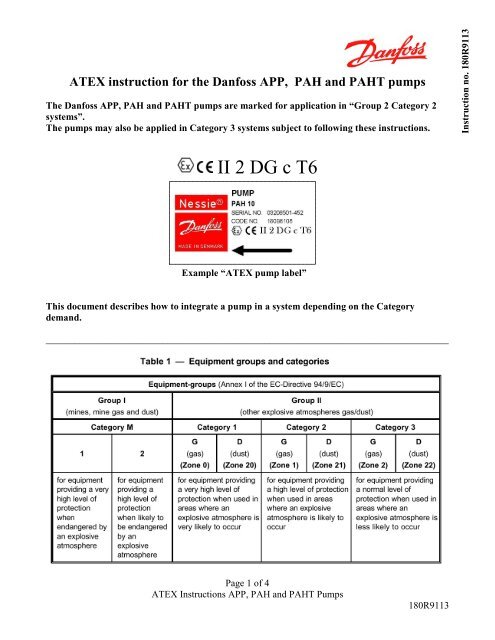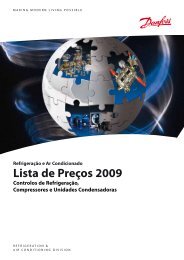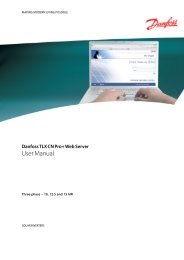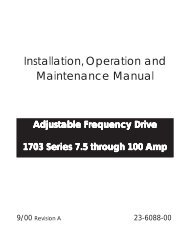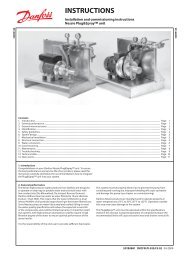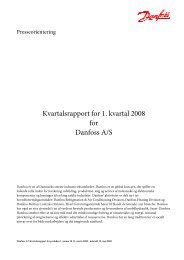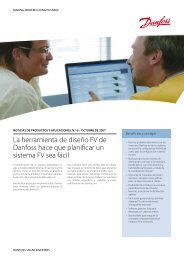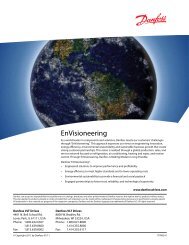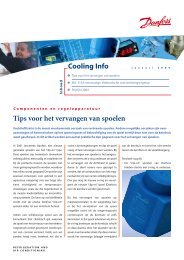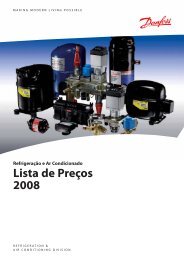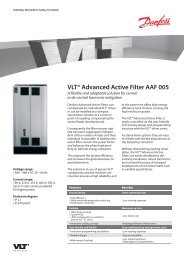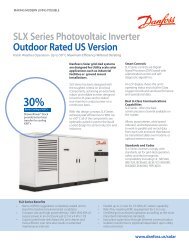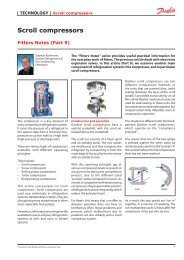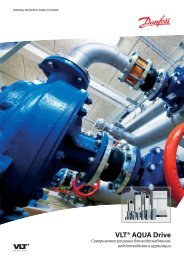ATEX instruction - Danfoss
ATEX instruction - Danfoss
ATEX instruction - Danfoss
You also want an ePaper? Increase the reach of your titles
YUMPU automatically turns print PDFs into web optimized ePapers that Google loves.
<strong>ATEX</strong> <strong>instruction</strong> for the <strong>Danfoss</strong> APP, PAH and PAHT pumps<br />
The <strong>Danfoss</strong> APP, PAH and PAHT pumps are marked for application in “Group 2 Category 2<br />
systems”.<br />
The pumps may also be applied in Category 3 systems subject to following these <strong>instruction</strong>s.<br />
II 2 DG c T6<br />
Example “<strong>ATEX</strong> pump label”<br />
This document describes how to integrate a pump in a system depending on the Category<br />
demand.<br />
___________________________________________________________________________________<br />
Page 1 of 4<br />
<strong>ATEX</strong> Instructions APP, PAH and PAHT Pumps<br />
180R9113<br />
Instruction no. 180R9113
Common demands for Category 2 and 3 installations<br />
___________________________________________________________________________________<br />
This <strong>instruction</strong> is a supplement to existing product <strong>instruction</strong> as <strong>ATEX</strong> components are subject<br />
to some limitations compared to standard components. The limitations are described in this<br />
<strong>ATEX</strong> <strong>instruction</strong>.<br />
Validity:<br />
Approvals are only related to water as fluid. If other fluids are used these must be non-flammable<br />
fluids and comply with standard EN 13463-5 § 7.5.5.<br />
The pumps are designed to pump liquids and not gasses! It is the user’s responsibility that the pump is<br />
fluid filled.<br />
Fluids:<br />
If the pump is to operate on other fluids than water, please contact <strong>Danfoss</strong>. Other operation and<br />
maintenance conditions might apply.<br />
Minimum suction pressure:<br />
The user must always ensure that the pump is filled with the fluid to be pumped. The pumps must<br />
always be operated with a “positive head” on suction port. The allowable minimum and maximum<br />
inlet pressure for the suction port can be found in the pump data sheet.<br />
Maximum discharge pressure:<br />
It is the user’s responsibility that the pump discharge pressure does not exceed the max continuous<br />
discharge pressure + 10% stated in the pump data sheet.<br />
Temperature:<br />
The pump is not to be used in systems where the fluid temperature exceeds 50°C /122°F.<br />
Filtration:<br />
The fluids entering the pump must as a minimum always be filtered according to the specification<br />
found in the technical pump data sheet<br />
Page 2 of 4<br />
<strong>ATEX</strong> Instructions APP, PAH and PAHT Pumps<br />
180R9113
Common demands for Category 2 and 3 (continued)<br />
_________________________________________________________________________________<br />
External impacts due to:<br />
Gases:<br />
The pumps are made in materials resistant to most common gases. The user of the pump must ensure<br />
that materials used are resistant to the gases applied.<br />
Dust:<br />
The pumps may be used in “Dust Certified Areas “– but the pump housing must be cleaned regularly<br />
and always when the dust layer is exceeding 5 mm (0.2 Inch). It is the user’s responsibility that<br />
materials applied for the pump are compatible with the dust generated.<br />
___________________________________________________________________________________<br />
Assembly of pump drive unit:<br />
Motor - Pump assembly and system integration:<br />
When assembling the pump with the bell housing, flexible couplings and motor, it is the builder’s<br />
responsibility that the parts used conform to the <strong>ATEX</strong> directive and that the components are<br />
assembled and running according to the operational data found in product data sheets and <strong>instruction</strong>s.<br />
___________________________________________________________________________________<br />
“Potential equalizing cables” for pump systems installed in Category 3 areas:<br />
All parts must be potential equalized,<br />
in a Category 3 system, a conductive (i.e. metallic) bell housing can be applied for equalizing the<br />
electrical potentials between motor and pump. Pump and motor must be mounted on the bell housing<br />
by bolts and lock washers; this will ensure electrical contact between pump and motor.<br />
Page 3 of 4<br />
<strong>ATEX</strong> Instructions APP, PAH and PAHT Pumps<br />
180R9113
Requirements for Category 2 installations:<br />
___________________________________________________________________________________<br />
“Potential equalizing cables” for systems installed in Category 2 areas:<br />
All parts must be potential equalized,<br />
in a Category 2 system, all parts must be potential equalized by electrical wires. The wire gauge must<br />
be equal to the wire gauge applied in the “supply” of the electric motor and may as a minimum not be<br />
smaller than 4mm 2 . (EN 60079-0 Item15.4).<br />
___________________________________________________________________________________<br />
Pump housing temperature increase causing problems due to pump breakdown/failure in a<br />
Category 2 rated system<br />
In a Category 2 system, the pump housing temperature must be monitored.<br />
Pump housing temperature must always be lower than 85°C / 185°F.<br />
A sensor integrated in or on the pump must be used to monitor pump housing temperature. This sensor<br />
can either be mounted on top of the pumps cylindrical part or in the drain/bleed port of the pump. The<br />
system must stop the pump, if a temperature of 60°C / 140°F is exceeded.<br />
__________________________________________________________________________________<br />
Checking whether suction port is fluid filled and fluid flows unrestricted:<br />
To monitor if suction line is fluid filled at right pressure, a pressure sensor must be placed in the pump<br />
suction port. This sensor must as a minimum be set to the minimum suction pressure specified in the<br />
pump data sheet. Pump must be stopped by system, if pressure declines below sensor pressure setting.<br />
__________________________________________________________________________________<br />
Page 4 of 4<br />
<strong>ATEX</strong> Instructions APP, PAH and PAHT Pumps<br />
180R9113


